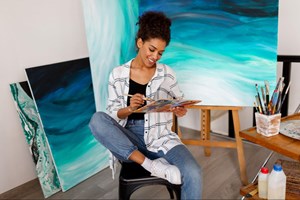
In 2020, the Covid-19 pandemic made face-to-face learning unsafe. Educational institutions, including art schools, had to conduct their courses online. Since then art schools have been revolutionizing how they teach.
In 2020, the Covid-19 pandemic made face-to-face learning unsafe. Educational institutions, including art schools, had to conduct their courses online. Since then art schools have been revolutionizing how they teach. For students, especially non-traditional learners, the ability to learn online can present new opportunities. To make online art education engaging, teachers have to adjust and adapt their teaching methods. They need to become familiar with the technology that helps them to do this.
The role of informative art essays in shaping the future of online art education
Writing informative essays on art topics is essential for students in the art industry for several reasons. Firstly, it helps students develop a deeper understanding of art history, theory, and practice. Through research and analysis, students gain valuable insights into various art movements, techniques, and artists. This knowledge not only enhances their appreciation of art but also equips them with a solid foundation to create their own meaningful and innovative works. They learn to evaluate and interpret artworks, discern underlying themes, and articulate their thoughts clearly, all of which are crucial for effective communication in the field.
Because writing an essay on art is so vital in the digital age, there are numerous ways for a student to make this assignment easier. Essay writing services EduBirdie shares informative essay examples that serve as valuable educational resources, providing students with a wealth of well-structured and thoroughly researched essays on various art topics. These examples can be a source of inspiration, helping students understand the nuances of effective essay writing, including structure, argumentation, and citation. They offer a clear benchmark for what constitutes a high-quality informative art essay, giving students a tangible goal to work towards. Students can explore diverse perspectives and approaches to art-related topics, enriching their own understanding and encouraging them to think creatively.
Tailoring education to the contemporary art landscape
Online learning is convenient and makes education accessible to many more people. Students appreciate the flexibility it offers. Teachers can use current technology to create online videos for art courses. Students can access these videos whenever they choose to do so. This helps them to balance studying or caregiving with learning. In a traditional classroom, the teacher must proceed at a pace suitable for the whole class but this isn’t the case with online learning.
Learning online gives students access to a wider range of art styles and practices. The skills they develop, such as creative critical thinking, can help them in everyday life. Exploring various forms of art can make them more culturally aware and tolerant of others. They can learn how to accept constructive feedback. Art courses can also teach students social-emotional skills which helps them to manage their emotions.
Use of digital apps
Students are as likely to create art using computers as they are to draw, paint, or sculpt by hand. Education technology trends include the increasing use of digital apps. This can free art students to express themselves in new ways. Drawing and illustration apps can help them to overcome some of the limits they place on themselves.
The future of education technology is likely to see the development of many more digital art apps.
Social connection and feedback
Art students may fear that learning art online doesn’t offer as much social connection or the feedback they need. In fact, there are many different ways for students to connect, communicate, and receive feedback when learning online. Future education technology is likely to incorporate more use of AI for these purposes.

Photo: https://www.freepik.com/free-photo/top-view-woman-drawing-ipad_36079282.htm
Art schools must offer comprehensive online programs
Online students often know what they want to study before they apply. Schools with a comprehensive suite of online programs have an advantage. When students have access to the right tools and resources, art education can prepare them effectively for success in the modern world. Students highly value flexibility and accessibility when choosing an online art program.
Teachers will need to become more familiar with how to incorporate technology in teaching art. The future of edtech could see many new innovations in online art education. Teachers will have to be continuously open to new ways of teaching.
Conclusion
The future of online art education will see the use of many online tools and resources to engage art students. They will develop their creativity and other useful skills. Online artist communities are often very supportive and can offer the feedback they need. Art schools need to offer comprehensive programs and make sure they keep up with future trends and practices.

ArtDependence Magazine is an international magazine covering all spheres of contemporary art, as well as modern and classical art.
ArtDependence features the latest art news, highlighting interviews with today’s most influential artists, galleries, curators, collectors, fair directors and individuals at the axis of the arts.
The magazine also covers series of articles and reviews on critical art events, new publications and other foremost happenings in the art world.
If you would like to submit events or editorial content to ArtDependence Magazine, please feel free to reach the magazine via the contact page.